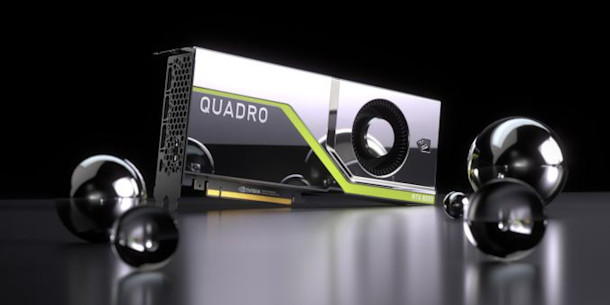Nvidia unveils Quadro RTX 5000, 6000 and 8000 GPUs

Nvidia has announced three new additions to its Quadro range of professional workstation graphics cards: the Quadro RTX 5000, Quadro RTX 6000 and Quadro RTX 8000.
The cards – the first to be based on Nvidia’s new Turing architecture, and billed as “the world’s first ray tracing GPUs” – were announced at Siggraph 2018.
Nvidia’s new Turing architecture: new dedicated ‘RT cores’ to accelerate ray tracing
The Turing cards are the first commercial outing for RTX, Nvidia’s hardware acceleration technology for the new DirectX Raytracing capabilities within DirectX 12.
Each features a set of RT cores – new dedicated ray tracing processors – alongside the two core types in Nvidia’s current-gen Volta architecture: CUDA, for general GPU compute, and Tensor, for AI inferencing.
Nvidia claims that the Turing architecture accelerates ray tracing operations by 25x over the earlier Pascal architecture still used in most of its current Quadro cards.
Turing also supports hybrid rendering – a mixture of ray tracing and rasterisation, intended to further accelerate complex jobs – with Nvidia claiming a 6x rasterisation speed boost over Pascal.
So how much faster will that actually make DCC software?
In its launch announcement, Nvidia claims that over two dozen key software firms are supporting Turing.
In most cases, that currently just seems to mean ‘the software will run on Turing GPUs’, but there is one hard figure in the list: Otoy reports that the path tracing kernel in its upcoming OctaneRender 2019.x runs at 3.2 GigaRays/s on the new Quadro RTX 6000 compared to 0.4 GigaRays/s on the existing Quadro P6000.
While that’s less than Nvidia’s ballpark figure of 25x, it’s still a pretty respectable 8x performance boost.
Chaos Group has also posted a tech demo of Project Lavina, its work-in-progress real time ray tracing technology, rendering a 300-billion-triangle scene at 25fps on a single Quadro RTX 6000.
Switching from GDDR5 and GDDR5X memory to the new GDDR6
Other changes in the Turing cards include the introduction of GDDR6 memory, which provides a moderate increase in data transfer rates over the GDDR5X memory used in the higher-end Pascal GPUs.
If you want the fine detail, Anandtech has a thorough analysis of the Turing architecture.
The new Quadro RTX 5000, 6000 and 8000: powerful cards for artists with deep pockets
Whereas AMD’s pitch for its recent workstation GPUs has been very much value for money, Nvidia has focused more on absolute performance – and premium price points.
Accordingly, the three new cards slot in at the top end of its Quadro line-up, with the RTX 5000 and RTX 6000 essentially superseding the older P5000 and P6000.
As you can see from the table below, each has roughly the same price point as its predecessor, but more CUDA cores, with an attendant increase in single-precision floating-point compute performance.
VRAM capacity stays the same – and equals or exceeds that of the Radeon Pro WX 9100, AMD’s current top-of-the-range workstation card – but trades up from GDDR5X to GDDR6.
And, obviously, you get those new RT cores for ray tracing.
| Nvidia Quadro workstation GPUs | |||||
|---|---|---|---|---|---|
| P5000 | RTX 5000 | P6000 | RTX 6000 | RTX 8000 | |
| Architecture | Pascal | Turing | Pascal | Turing | Turing |
| CUDA cores | 2,560 | 3,072 | 3,840 | 4,608 | 4,608 |
| Compute (FP32) | 8.9 Tflops | (10.6 Tflops) | 12 Tflops | (16 Tflops) | 16 Tflops |
| Ray tracing | – | 6 GigaRays/s | – | 10 GigaRays/s | 10 GigaRays/s |
| VRAM | 16GB GDDR5X |
16GB GDDR6 |
24GB GDDR5X |
24GB GDDR6 |
48GB GDDR6 |
| Launch date | Q4 2016 | Q4 2018 | Q4 2016 | Q4 2018 | Q4 2018 |
| Launch price | $2,499 | ($2,300) | $5,999 | ($6,300) | ($10,000) |
Figures in brackets represent estimated values.
The RTX 8000 is interesting: it has the same core specs as the RTX 6000, but at 48GB, twice the VRAM.
It also supports Nvidia’s NVLink multi-GPU technology, so if you need to render very large scenes on the GPU – and have very deep pockets – you can double up to 96GB by buying two cards.
Connectivity is identical across all three new cards, and fairly standard for this end of the market: four DisplayPort 1.4 outputs, plus a VirtuaLink port to connect future VR headsets via a USB-C connector.
Pricing and availability
All three Quadro RTX cards are due to ship later this year. The Quadro RTX 5000 has an estimated street price of $2,300; the RTX 6000 has an ESP of $6,300; and the RTX 8000 an ESP of $10,000.
Read Nvidia’s launch announcement for its new Turing GPU architecture and Quadro RTX GPUs
See specs for the Quadro RTX 5000, Quadro RTX 6000 and Quadro RTX 8000 on Nvidia’s website
